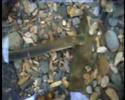BIO270 Laboratory Guide #1
VERTEBRATE PHYLOGENY I:
PROTOCHORDATES TO AGNATHANS
After completing this laboratory you should be able to:
1) Recognize and correctly use anatomical terms for planes of section, directions, and motions at joints;
2) Recognize and correctly classify representative protochordates and agnathans;
3) Identify the defining and distinguishing anatomical features of the protochordae and agnathan taxa as detatiled in the lists below.
I. ANATOMICAL TERMS
1) Read through K&Z exercises #1
2) Work through the K&Z exercises, using the human, goat, pelican, alligator and perch skeletons. Continue to quiz yourself and each other until you can recognize and correctly use the following sets of terms:
Anatomical Terms
(relative to the animal) / (relative to the ground)
A) Planes of section:
sagittal, midsagittal (median), parasagittal
coronal, frontal
transverse, cross
horizontal
B) Directions:
medial vs. lateral
ventral vs. dorsal / superior vs. inferior
rostral vs. caudal / anterior vs. posterior
proximal vs. distal
superficial vs. deep
C) Motions:
extension vs. flexion
elevation (levitation) vs. depression
adduction vs. abduction v. circumduction
medial rotation vs. lateral rotation
pronation vs. supination
inversion vs. eversion
plantarflexion vs. dorsiflexion
II. PROTOCHORDATES
1) Work through K&Z exercise #2 with the prepared specimens of acorn worms, tunicates, and lancelets (amphioxus).
2) Using dissecting and/or compound microscopes as necessary, identify external and internal structures labeled in the figures, using the list below as a guide. Familiarize yourself with the major defining and distinguishing anatomical features of these taxa.
3) Dissect the available preserved protochordate specimens and try to identify the same structures from the K&Z manual and the list below.
Structures to identify:
Hemichordata - (acorn worms)
proboscis with stomochord
collar
gill slits
Cephalochordata (lancelets):
notochord
dorsal hollow nerve chord
buccal cirri
velar scroll
branchial basket with gill slits
gut
segmental myomeres
anus
post-anal tail
Urochordata - (tunicates)
incurrent siphon
excurrent siphon
branchial basket with gill slits
digestive tract
III. AGNATHANS
1) Work through K&Z exercise #3 with the plasticized and preserved lamprey specimens. Identify external and internal structures labeled in the figures. Familiarize yourself with the major defining and distinguishing anatomical features of lampreys and hagfish.
2) Compare the ammocoetes larva (lamprey), tunicate larva, and adult lancelets. Pay particular attention to identifying each of the the four defining structural features of the Chordata.
Structures to identify:
external:
buccal cavity with teeth
gill slits
eyes
dorsal nostril
dorsal and caudal fins
urogenital papilla
post-anal tail
internal:
notochord
dorsal hollow nerve chord
olfactory sac
brain
pharynx
liver
intestine
epiaxial and hypoaxial muscles












